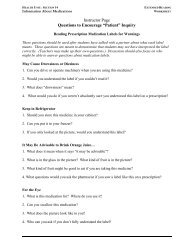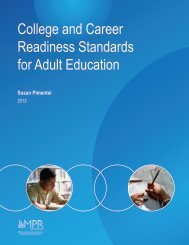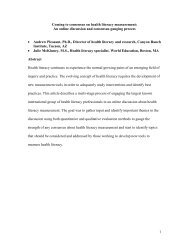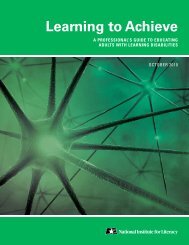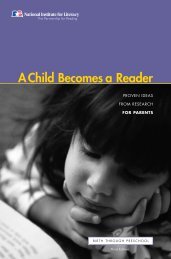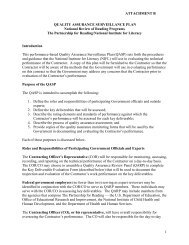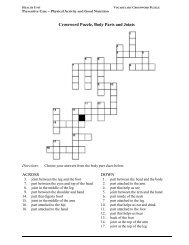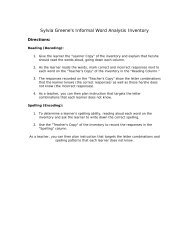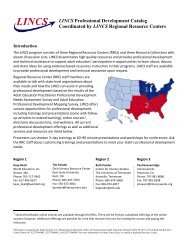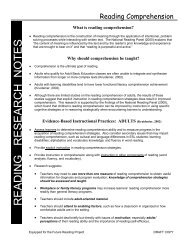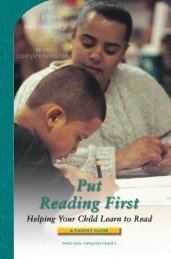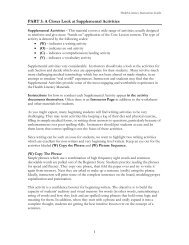READING RESEARCH NOTES - LINCS
READING RESEARCH NOTES - LINCS
READING RESEARCH NOTES - LINCS
Create successful ePaper yourself
Turn your PDF publications into a flip-book with our unique Google optimized e-Paper software.
Reading ComprehensionWhat is reading comprehension?<strong>READING</strong> <strong>RESEARCH</strong> <strong>NOTES</strong>♦ Reading comprehension is the construction of meaning through the application of intentional, problemsolving processes while interacting with written text. The National Reading Panel (2000) explains that“the content of meaning is influenced by the text and by the reader’s prior knowledge and experiencethat are brought to bear on it” and that “reading is purposeful and active.”♦♦♦♦♦♦♦♦Comprehension is the ultimate goal of reading.Why should comprehension be taught?Adults who qualify for Adult Basic Education classes are often unable to integrate and synthesizeinformation from longer or more complex texts (Kruidenier, 2002).Adults with learning disabilities tend to have lower functional literacy comprehension achievement(Kruidenier, 2002).Although there are limited studies on the reading comprehension of adults, the results of thesestudies suggest that explicit instruction in reading comprehension strategies does result in improvedcomprehension. This research is supported by the findings of the National Reading Panel (2000),which found that children’s reading comprehension can be improved by instruction in using specificcognitive strategies or in reasoning strategically when encountering barriers to understanding.Evidence-Based Instructional Practices: ADULTS (Kruidenier, 2002)Assess learners to determine reading comprehension ability and to measure progress in theacquisition of reading comprehension strategies. Also consider secondary issues that may impactreading comprehension, such as cultural and language differences in ESL students; learningdisabilities; alphabetics and vocabulary knowledge; and fluency in word reading.Provide explicit instruction in reading comprehension strategies.Provide instruction in comprehension along with instruction in other components of reading (wordanalysis, fluency, and vocabulary).Research suggests:• Teachers may need to use more than one measure of reading comprehension to obtain usefulinformation for diagnosis and program evaluation; knowledge of comprehension strategiesshould be assessed and taught.• Workplace or family literacy programs may increase learners’ reading comprehension morereadily than general literacy programs.• Teachers should include adult-oriented material.• Teachers should attend to enabling factors, such as how a classroom in organized or howcomfortable adults are in the setting.• Teachers should deal briefly but directly with issues of motivation, especially adults’perceptions of their reading ability and the importance of reading (self-efficacy).Equipped for the Future Reading ProjectDRAFT COPY
Evidence-Based Instructional Practices: CHILDREN (NRP, 2000)♦Provide explicit instruction and practice in the following:<strong>READING</strong> <strong>RESEARCH</strong> <strong>NOTES</strong>♦♦♦♦‣ comprehension monitoring: readers learn to be aware of when they do not understand the text and howto use fix-up strategies.‣ graphic and semantic organizers: readers make graphic representations, including story maps, of thematerial to assist comprehension.‣ question answering: readers answer questions posed by the teacher and receive immediate feedbac.k‣ question generating: readers learn to ask themselves questions about various aspects of the text.‣ story structure: readers learn to ask and answer who, what, where, when, and why questions about theplot and/or to map out the time line, characters, and events in stories.‣ summarizing: readers learn to identify and write the most important ideas that integrate separate ideas ormeanings into a coherent whole.‣ multiple strategy instruction: students learn to use a combination of strategies appropriate for the readingtask.Provide tasks that demand active involvement.Scaffold new learning, gradually withdrawing the amount of assistance offered to the learner.• Direct explanation• Modeling• Guided practice• ApplicationEngage learners in cooperative learning, in which readers instruct or interact with each other to learntext comprehension strategies.Encourage students to use comprehension strategies flexibly and in combination.SourcesKruidenier, John (2002). Research-Based Principles for Adult Basic Education Reading Instruction.Washington, DC: National Institute for Literacy, Partnership for Reading.National Reading Panel (2000). Teaching Children to Read: an Evidence-Based Assessment of theScientific Research Literature on Reading and its Implications for Reading Instruction (Report of theSubgroups). Washington, D.C.: National Institute for Child Health and Human Development.Equipped for the Future Reading ProjectDRAFT COPY
Evidence-Based Instructional Practices: ADULTS (Kruidenier, 2002)<strong>READING</strong> <strong>RESEARCH</strong> <strong>NOTES</strong>♦♦♦♦♦♦♦♦♦♦♦♦Assess beginning readers’ phonemic awareness, phonics abilities, and sight wordknowledge. Since adult beginning readers are generally better at recognizing familiar sightwords than children who are learning to read, avoid using sight words adults may know forphonics assessments.Provide adult beginning readers with a significant amount of alphabetics instruction, inconjunction with other aspects of reading.Continue to assess PA in beginning readers, even if their overall reading scores are goingup. Research suggests that adults with a learning disability in reading may not developphonemic awareness as they learn to read; thus, attending to PA development may helpteachers identify those students who need more in-depth work with PA or who needinstruction that bypasses PA.Evidence-Based Instructional Practices: CHILDREN (NRP, 2000)Explicitly and systematically teach children to manipulate phonemes with letters.Focus instruction on 1-2 types of phoneme manipulation, instead of on multiple types.Segmenting and blending seem to be the most important manipulations to teach.Teach phonemic awareness in small groups. (Research shows no difference in theeffectiveness of phonics instruction provided to individuals, small groups, or whole classes.)Monitor PA learning carefully. Students who do not respond to PA instruction may have areading disability.Use some form of systematic phonics instruction. Teach a carefully selected and useful setof letter-sound relationships, organized into a logical instructional sequence. (It does notseem to matter whether or not the approach asks readers to turn letters into sounds, useanalogies, or notice spelling patterns.)Encourage readers to apply their phonics knowledge while reading connected text andwriting.Provide instruction in the other essential elements (phonemic awareness, fluency,vocabulary, text comprehension).Begin phonics instruction in kindergarten or 1 st grade and continue for about 2 years.Consider motivational issues.SourcesKruidenier, John (2002). Research-Based Principles for Adult Basic Education Reading Instruction.Washington, DC: National Institute for Literacy, Partnership for Reading.National Reading Panel (2000). Teaching Children to Read: an Evidence-Based Assessment of theScientific Research Literature on Reading and its Implications for Reading Instruction (Report of theSubgroups). Washington, D.C.: National Institute for Child Health and Human Development.Equipped for the Future Reading ProjectDRAFT COPY
Evidence-Based Instructional Practices: CHILDREN (NRP, 2000)♦ Provide opportunities for learners to learn new words in rich contexts .♦Words that are taught should be appropriate for learners’ age and ability level.<strong>READING</strong> <strong>RESEARCH</strong> <strong>NOTES</strong>♦ Teach vocabulary directly in ways that actively engage learners. Introducing words beforereading texts has been found to be effective.♦ Expose learners to words through read-alouds, discussion, and independent reading (inmaterial they can read fluently).♦ Provide opportunities for repetition and multiple exposures to new words.♦ Explore computers as a way to teach vocabulary.♦ Use a variety of instructional methods for teaching vocabulary.SourcesKruidenier, John (2002). Research-Based Principles for Adult Basic Education Reading Instruction.Washington, DC: National Institute for Literacy, Partnership for Reading.National Reading Panel (2000). Teaching Children to Read: an Evidence-Based Assessment of theScientific Research Literature on Reading and its Implications for Reading Instruction (Report of theSubgroups). Washington, D.C.: National Institute for Child Health and Human Development.Equipped for the Future Reading ProjectDRAFT COPY
FluencyWhat is fluency?<strong>READING</strong> <strong>RESEARCH</strong> <strong>NOTES</strong>Fluency is the ability to read rapidly and accurately, with appropriate rhythm, intonation, andexpression. Fluency includes the ability to decode rapidly, grouping words into meaningful unitsfor interpretation. Fluency includes pronunciation, determination of emphasis, and appropriatepauses to make sense of text. Fluency is a means readers use to comprehend.Why should fluency be taught?• Readers face two major cognitive demands: decoding (recognizing words) andcomprehending. Since cognitive resources to meet these demands are limited, resourcesexpended on word recognition reduce the resources available for comprehension. Skilledreaders recognize words with automaticity, freeing resources to group words into meaningfulunits (phrasing), attend to punctuation, and ultimately gain meaning from text. Poor readersuse time and resources to decode; their choppy and inaccurate reading impedescomprehension.• Fluency is an issue for adult beginning readers, intermediate, and perhaps advancedreaders. There are large differences between adults with good and poor reading fluency,and adult beginning readers’ fluency is similar to the fluency of children who are beginningreaders. (Kruidenier, 2002)• Fluency may be taught to ABE students, and fluency practice may lead to increases inreading achievement. (Kruidenier, 2002)Evidence-Based Practices for Instruction: ADULTS (Kruidinier, 2002)• Assess fluency to determine whether fluency instruction is needed. For lower-level readers,one way to determine fluency is by measuring accuracy of decoding and rate of oralreading.• Use approaches that include repeated reading of passages of text, words from texts, andother text units. Some examples of repeated reading approaches include:‣ Listening to taped versions of passages‣ Simultaneously reading passages aloud while using typed transcripts‣ Giving students passages that are one grade level above their grade equivalent scoreson a test of reading comprehension ability‣ Re-reading a passage while listening until students feel able to read it aloud on their ownto the instructor‣ Reading two passages with 90% accuracy (mispronouncing no more than 10%) of wordsin a passage) before moving on the next grade level.• Use systematic phonics instruction to improve fluency.Equipped for the Future Reading ProjectDRAFT COPY
Evidence-Based Practices for Instruction: CHILDREN (NRP, 2000)<strong>READING</strong> <strong>RESEARCH</strong> <strong>NOTES</strong>• Provide opportunities for readers to read passages orally multiple times withguidance and feedback from teachers, peers, or parents. The following practicesseem to offer effective repeated reading experiences:Sources‣ Paired reading‣ Shared reading‣ Collaborative oral reading‣ Echo reading‣ Tape-assisted or computer-assisted oral readingKruidenier, John (2002). Research-Based Principles for Adult Basic Education Reading Instruction.Washington, DC: National Institute for Literacy, Partnership for Reading.National Reading Panel (2000). Teaching Children to Read: an Evidence-Based Assessment of theScientific Research Literature on Reading and its Implications for Reading Instruction (Report of theSubgroups). Washington, D.C.: National Institute for Child Health and Human Development.Equipped for the Future Reading ProjectDRAFT COPY





